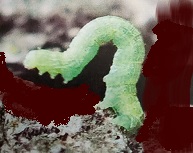Indian River County, Florida, recently had an “Inchworm” infestation. In one 4-day period, UF/IFAS Extension Indian River County had 10 residents contact the county Cooperative Extension office concerned about the same problem. That problem was their live oak trees being defoliated and thousands of “green worms”,

or “inchworms”, falling from the trees. And more of the same “worms” covering outdoor structures such as mailboxes, cars, and patios. Every one of these calls were from one small area on the barrier island in Indian River County.
After examining a few samples brought into the UF/IFAS Extension Indian River County office by residents, we were able to determine that these were, indeed, “Inchworm” caterpillars, also called “Spring Cankerworm”, Paleacrita vernata.
Caterpillar Life Cycle
Back in Late August, these residents probably did not notice the numbers of small adult male moths around their live oak tree trunks. And especially not the wingless female climbing up the bark of their trees. After mating, the female finds a branch tip she likes, with new, unopened buds. She will then lay hundreds of eggs on the branch around the new buds.
This tree pest is common along the whole east coast of the North America. The University of New Hampshire has an illustrated publication on these insects entitled, “Cankerworm Fact Sheet“. It shows some fascinating photos of this species of moth and the stages of their life cycle.
If you have an outdoor light of any sort, you may have noticed a few non-descript, ¾-inch, tan moths flittering about the porch light on summer nights. There always are such moths around the light, of various species, at all times of the year, and attempts to identify them all can be tedious.

Now, however, six months later, we are seeing the results of the Spring Cankerworm moths’ successful mating: thousands and thousands of inch-long, sea-green caterpillars. This species neither bite people nor do they sting. They are not harmful to pets or small children if ingested. But these larvae can be an important food source for many species of native birds and migrating songbirds. And in about a week, they will drop to the ground to pupate in a cocoon below the soil and you will most likely forget all about them.
Their life cycle is amazing. The female Cankerworm moths are flightless, having no wings at all. Yet she still resembles a moth in body shape. Only the males are capable of flight. After mating, the female crawls up into the tree canopy to lay eggs on the tips of the branches of her chosen host tree.
Spring Cankerworm’s Favorite Host Trees:
- Maple (Acer spp.)
- Elm (Ulmus spp.)
- Oak (Quercus spp.)
- Prunus species (Cherry, Nectarine, Peach, plum, apricot)
- Birch (Betula spp.)
- and other tree species
In early spring, as the new tree leaf buds open, the eggs hatch into very tiny larvae. Each caterpillar will eat into the newly emerging leaf tips. At first, the damage is small and the leaves are only skeletonized. However, as the caterpillars grow, they begin devouring the whole leaf tips. If infestations are severe enough over several years, inchworms could damage to severely stress trees, possibly causing the trees to become susceptible to disease.
Once the caterpillars are about a half-inch to 1-inch long, they use a silk “rappel line” to gently lower themselves down to the soil where they will make a cocoon underground in which to pupate. The next generation emerge from the ground in summer and repeat the cycle.
There are many insects and insect larvae which live at least part of their life in our native oak trees. Most of the time, these are the only food source for our native birds. With the prevalence of insecticides available to the public, people often reach for the insecticide before they fully understand how our arboreal ecosystem works or if it is even necessary to treat for insects.
Preventing a Huge Infestation

Though there is an “Ick” factor for some residents when they see small green creeping things, it is not usually recommended to spray your trees to kill these creatures. The overspray of caterpillar killer (Bacillus theringiensis) will kill most larval insect life in the area, reducing the good insect populations along with the insect pests. This decreases songbird food supplies.
Alternatively, many people have had some success with “banding” their trees in early summer. This involves making a trap strip around the trunks of the trees. Quilt batting is placed underneath cling-wrap, which is wrapped around the tree trunk. The batting prevents the moths from getting under the trap through any bark fissures. An application of a sticky resin called “Tanglefoot” is smeared in a 6-inch-wide strip around the middle of the cling wrap. These sticky sections trap the gravid, flightless females as they climb up the trunk of the tree, preventing them from laying their eggs on the branch tips.
This does not capture all of them but will cut down their population significantly. These bands should be checked often to be sure the moths are not creating a bridge for others to crawl over. “Youtube” has many “trap strip” tutorial videos for this procedure. However, I would NOT recommend the use of fiberglass batting which could cause other biological hazards. Other natural options could be wool or cotton batting.
The University of Florida’s Institute of Food and Agricultural Sciences Electronic Data Information Source (UF/IFAS EDIS) Publication, “Do It Yourself Insect Pest Traps” has some pretty inventive, homemade insect pest trap ideas anyone can make at home with common items. “Natural Products for Managing Landscape and Garden Pests in Florida” is another helpful UF/IFAS EDIS publication just right for you if you are trying to steer clear of many harsh chemical pesticides in your landscape and garden.
 2
2
